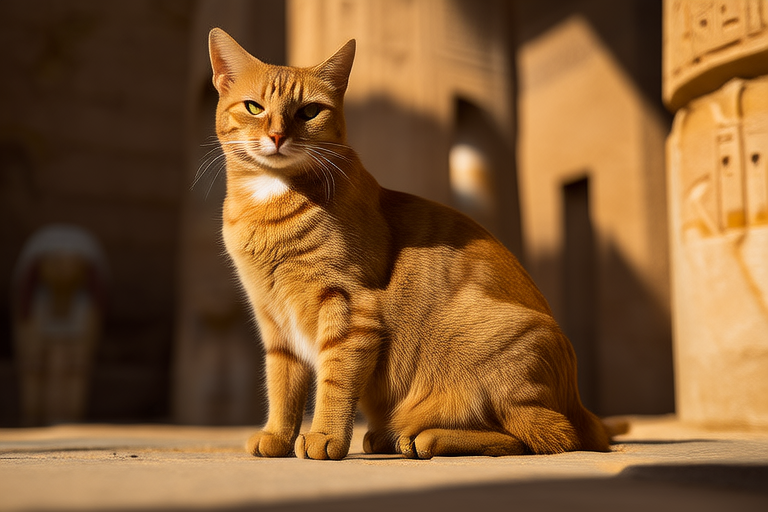From Temple to Home: The Journey of the Abyssinian Cat
The Abyssinian cat, with its distinctive ticked coat and captivating green eyes, has captivated the hearts of many since ancient times. This elegant feline’s story begins in the temples of ancient Egypt, where it was revered as a symbol of grace and divinity. From its origins in the shadow of towering pyramids to its current status as a beloved companion in homes worldwide, the Abyssinian cat’s journey is one of transformation and enduring charm.
Origins in Ancient Egypt
The Abyssinian cat’s roots can be traced back to the fertile lands of ancient Egypt. These graceful creatures were often depicted in hieroglyphics and statues, indicating their significant place in Egyptian society. Egyptians held cats in high regard, associating them with deities like Bastet, the goddess of protection, fertility, and motherhood. The Abyssinian, with its sleek build and expressive eyes, was believed to possess divine qualities, making it a favored pet among the elite.
Their unique appearance, characterized by a ticked coat pattern and slender physique, set them apart from other domesticated cats. This distinctive look was thought to be a result of natural selection, where the cats adapted to the hot desert climate by developing a light, reflective coat that helped them regulate body temperature. This adaptation not only made them more comfortable in their environment but also enhanced their hunting abilities, contributing to their revered status.
Spread Across Continents
The journey of the Abyssinian cat from ancient Egypt to the modern world is marked by significant milestones. The first documented mention of Abyssinian cats in Europe occurred in the mid-19th century when they were brought back by British soldiers who had served in Abyssinia (modern-day Ethiopia). These soldiers recognized the unique beauty of the cats and introduced them to the British aristocracy, who quickly took a liking to them.
The first official Abyssinian cat exhibit at a cat show took place in England in 1871, at the Crystal Palace Show. This event marked the beginning of Abyssinians’ recognition in the competitive cat world. Over the years, breeders worked diligently to refine the breed’s characteristics, ensuring that the cats retained their signature traits while improving their health and temperament.
Abyssinians were eventually introduced to the United States in the early 20th century. Their popularity grew steadily, and by the mid-20th century, they were well-established in cat shows and households across North America. Today, Abyssinians are one of the most sought-after breeds, admired for their striking appearance and engaging personalities.
Key Characteristics
What makes the Abyssinian cat so beloved? Their lively temperament and striking coat patterns are key factors. Abyssinians are known for their high energy levels and curiosity, which often lead them to explore every nook and cranny of their home. They are highly intelligent and enjoy interactive play, making them excellent companions for those who appreciate an active pet.
Their coat, which features a unique ticking pattern, is another standout feature. Each hair on an Abyssinian’s coat has bands of color, creating a mink-like appearance. This coat comes in various colors, including ruddy (the traditional color), blue, fawn, and cinnamon. The ticking pattern, combined with their large, expressive green or gold eyes, gives them an almost wild and exotic appearance.
Besides their physical attributes, Abyssinians are known for their friendly and affectionate nature. They are generally good with children and other pets, making them ideal for families. However, their independent streak means they may not always seek constant attention, preferring instead to engage in solitary activities or observe from a distance.
The Modern Role of Abyssinians
In modern times, Abyssinian cats have transitioned from sacred temple guardians to cherished family members. Their presence in homes around the world is a testament to their enduring appeal. These cats bring joy and companionship to their owners, offering a blend of independence and affection that many find irresistible.
As pets, Abyssinians require regular grooming to maintain their beautiful coats. Their playful and curious nature means they thrive in environments that provide mental and physical stimulation. Interactive toys and climbing structures can help keep them engaged and healthy. Additionally, their intelligence makes them quick learners, and many owners enjoy teaching their Abyssinians tricks or training them to perform specific behaviors.
The Abyssinian’s journey from temple to home is a remarkable tale of transformation and adaptation. From being revered in ancient Egypt to becoming cherished companions in modern households, these cats have captured the hearts of people worldwide. Their unique appearance, lively temperament, and friendly nature make them a standout breed among cat enthusiasts.
Today, Abyssinians continue to enchant and delight their owners with their charm and personality. Whether lounging in a sunbeam or engaging in play, these cats bring warmth and joy to the lives of those lucky enough to share their homes with them. As we celebrate the modern role of Abyssinians, let us also honor their rich history and the legacy they carry with them from ancient times.
